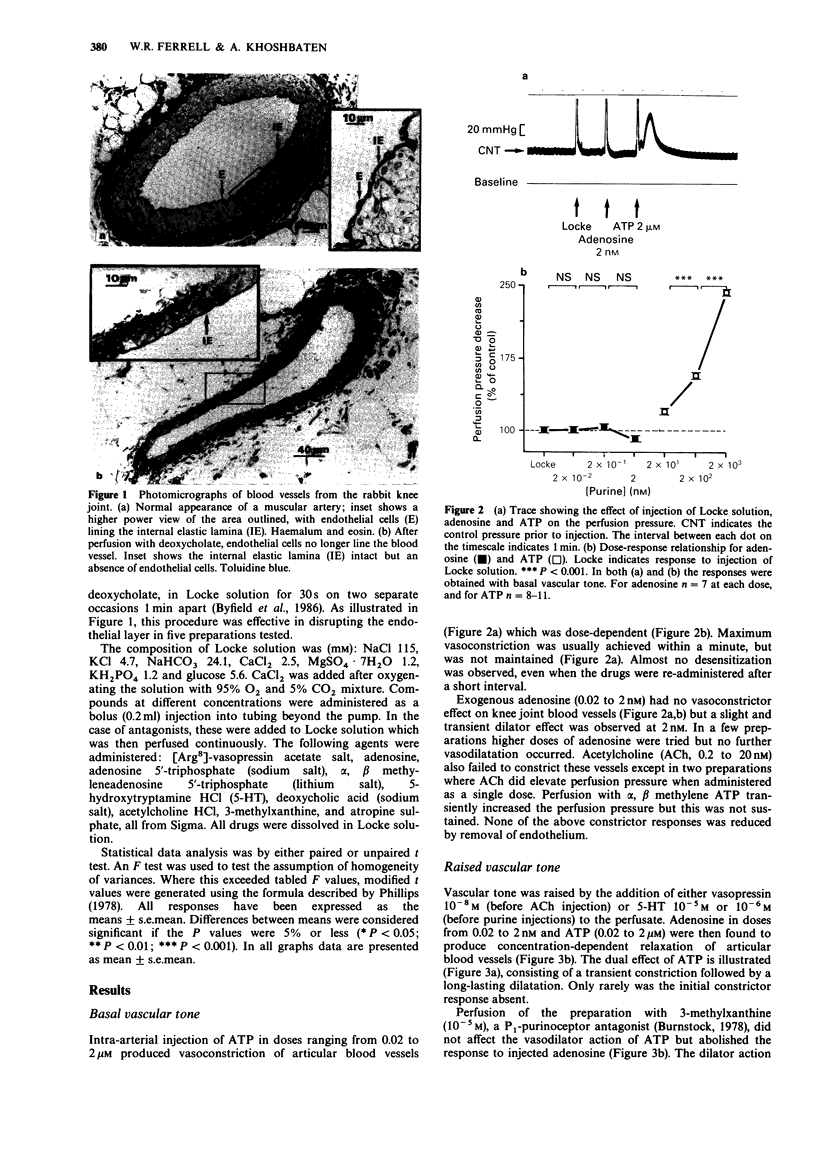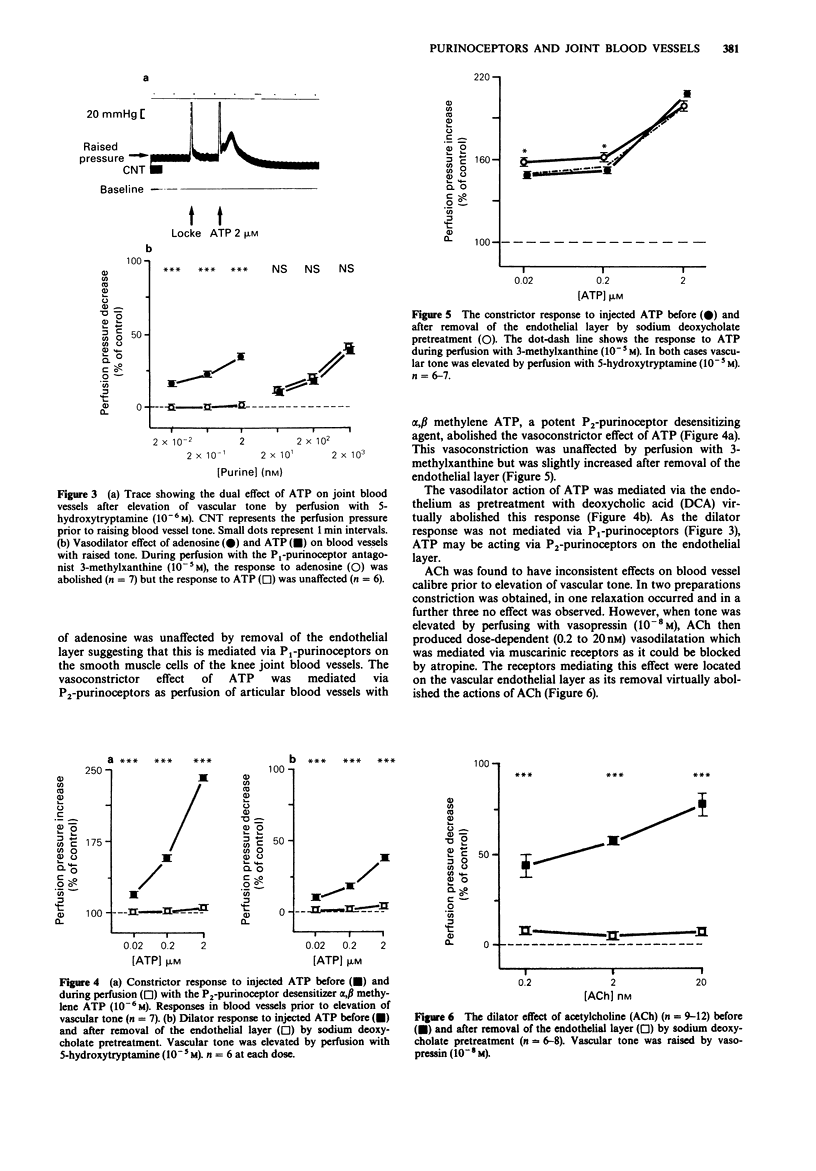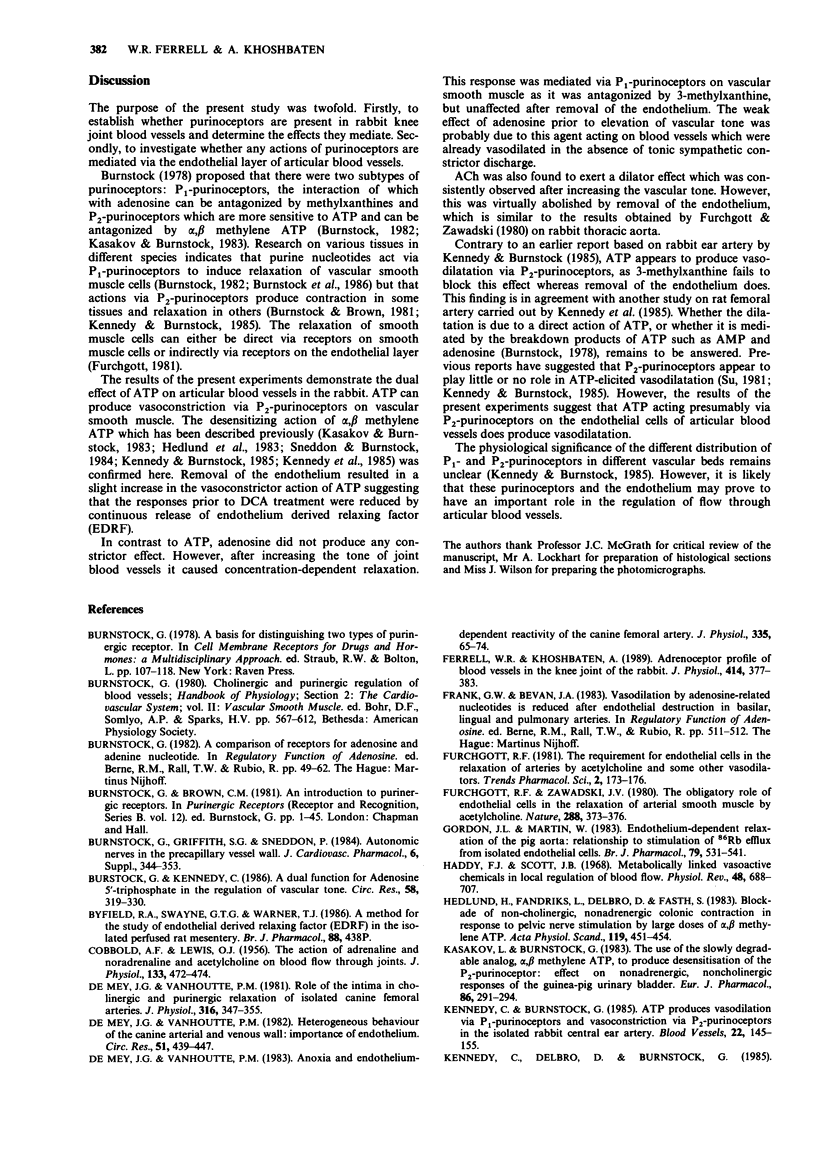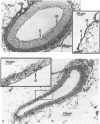Abstract
1. An in vitro preparation of the rabbit knee joint, perfused with oxygenated Locke solution, was used to investigate the presence of purinoceptors and the role of endothelium within articular blood vessels. 2. The basal tone of the blood vessels was not affected by adenosine or acetylcholine. Adenosine 5'-triphosphate (ATP) injection produced vasoconstriction which was unaffected by removal of the endothelial layer, but diminished by alpha, beta methylene ATP, a compound which desensitizes P2-purinoceptors. 3. When knee joint blood vessel tone was raised by perfusion with vasopressin (10(-8) M) or 5-hydroxytryptamine (10(-5) M), acetylcholine, ATP and adenosine were all found to induce concentration-dependent relaxation of these vessels. ATP was found to have a dual effect of transient constriction followed by longer-lasting dilatation. 4. 3-Methylxanthine, a P1-purinoceptor antagonist significantly reduced the relaxation response to adenosine but had no effect on the vasodilator effect of ATP. 5. Removal of the endothelial layer virtually abolished the vasodilator effects of acetylcholine and ATP but not adenosine. 6. These results demonstrate that articular blood vessels supplying the rabbit knee contain P1-purinoceptors located on the vascular smooth muscle which mediate vasodilatation. P2-purinoceptors mediating a constrictor effect are also present on this smooth muscle. It is likely that the vasodilator effect of ATP is mediated via P2-purinoceptors located on the endothelial layer.
Full text
PDF




Images in this article
Selected References
These references are in PubMed. This may not be the complete list of references from this article.
- Burnstock G., Kennedy C. A dual function for adenosine 5'-triphosphate in the regulation of vascular tone. Excitatory cotransmitter with noradrenaline from perivascular nerves and locally released inhibitory intravascular agent. Circ Res. 1986 Mar;58(3):319–330. doi: 10.1161/01.res.58.3.319. [DOI] [PubMed] [Google Scholar]
- COBBOLD A. F., LEWIS O. J. The action of adrenaline, noradrenaline and acetylcholine on blood flow through joints. J Physiol. 1956 Aug 28;133(2):472–474. doi: 10.1113/jphysiol.1956.sp005602. [DOI] [PMC free article] [PubMed] [Google Scholar]
- De Mey J. G., Vanhoutte P. M. Anoxia and endothelium-dependent reactivity of the canine femoral artery. J Physiol. 1983 Feb;335:65–74. doi: 10.1113/jphysiol.1983.sp014519. [DOI] [PMC free article] [PubMed] [Google Scholar]
- De Mey J. G., Vanhoutte P. M. Heterogeneous behavior of the canine arterial and venous wall. Importance of the endothelium. Circ Res. 1982 Oct;51(4):439–447. doi: 10.1161/01.res.51.4.439. [DOI] [PubMed] [Google Scholar]
- De Mey J. G., Vanhoutte P. M. Role of the intima in cholinergic and purinergic relaxation of isolated canine femoral arteries. J Physiol. 1981 Jul;316:347–355. doi: 10.1113/jphysiol.1981.sp013792. [DOI] [PMC free article] [PubMed] [Google Scholar]
- Ferrell W. R., Khoshbaten A. Adrenoceptor profile of blood vessels in the knee joint of the rabbit. J Physiol. 1989 Jul;414:377–383. doi: 10.1113/jphysiol.1989.sp017693. [DOI] [PMC free article] [PubMed] [Google Scholar]
- Furchgott R. F., Zawadzki J. V. The obligatory role of endothelial cells in the relaxation of arterial smooth muscle by acetylcholine. Nature. 1980 Nov 27;288(5789):373–376. doi: 10.1038/288373a0. [DOI] [PubMed] [Google Scholar]
- Gordon J. L., Martin W. Endothelium-dependent relaxation of the pig aorta: relationship to stimulation of 86Rb efflux from isolated endothelial cells. Br J Pharmacol. 1983 Jun;79(2):531–541. doi: 10.1111/j.1476-5381.1983.tb11028.x. [DOI] [PMC free article] [PubMed] [Google Scholar]
- Haddy F. J., Scott J. B. Metabolically linked vasoactive chemicals in local regulation of blood flow. Physiol Rev. 1968 Oct;48(4):688–707. doi: 10.1152/physrev.1968.48.4.688. [DOI] [PubMed] [Google Scholar]
- Hedlund H., Fändriks L., Delbro D., Fasth S. Blockade of non-cholinergic non-adrenergic colonic contraction in response to pelvic nerve stimulation by large doses of alpha, beta-methylene ATP. Acta Physiol Scand. 1983 Dec;119(4):451–454. doi: 10.1111/j.1748-1716.1983.tb07361.x. [DOI] [PubMed] [Google Scholar]
- Kasakov L., Burnstock G. The use of the slowly degradable analog, alpha, beta-methylene ATP, to produce desensitisation of the P2-purinoceptor: effect on non-adrenergic, non-cholinergic responses of the guinea-pig urinary bladder. Eur J Pharmacol. 1982 Dec 24;86(2):291–294. doi: 10.1016/0014-2999(82)90330-2. [DOI] [PubMed] [Google Scholar]
- Kennedy C., Burnstock G. ATP produces vasodilation via P1 purinoceptors and vasoconstriction via P2 purinoceptors in the isolated rabbit central ear artery. Blood Vessels. 1985;22(3):145–155. doi: 10.1159/000158592. [DOI] [PubMed] [Google Scholar]
- Kennedy C., Delbro D., Burnstock G. P2-purinoceptors mediate both vasodilation (via the endothelium) and vasoconstriction of the isolated rat femoral artery. Eur J Pharmacol. 1985 Jan 2;107(2):161–168. doi: 10.1016/0014-2999(85)90055-x. [DOI] [PubMed] [Google Scholar]
- Sneddon P., Burnstock G. Inhibition of excitatory junction potentials in guinea-pig vas deferens by alpha, beta-methylene-ATP: further evidence for ATP and noradrenaline as cotransmitters. Eur J Pharmacol. 1984 Apr 13;100(1):85–90. doi: 10.1016/0014-2999(84)90318-2. [DOI] [PubMed] [Google Scholar]
- Vanhoutte P. M., Rimele T. J. Role of the endothelium in the control of vascular smooth muscle function. J Physiol (Paris) 1982;78(7):681–686. [PubMed] [Google Scholar]



